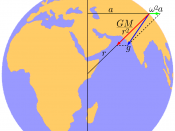Background Information:
A simple pendulum, such as a rock hanging from a piece of string or the inside of a grandfather clock, consists of a mass (the rock) and a support (the piece of string).
When the mass is moved a small distance away from its equilibrium point (the bottom of the arc), the mass will swing back and forth in a constant amount of time called the period. One period is the amount of time required for the mass to swing all the way to the other side and then swing back to its staring point.
Note: For the purpose of this assignment, we are making the simplifying assumption that our pendulum is swinging in a perfect vacuum, (i.e., there is no air resistance that will stop the pendulum).
The period of a simple pendulum is normally expressed using the variable T and is measured in seconds. It can be calculated using the length of the pendulum, L, and the acceleration due to gravity, g, using this expression:
The gravity that holds us on the earth and makes objects fall is familiar to all of us.
What may not be quite as well-known, however, is that the acceleration due to gravity is actually determined by the mass (amount of material) and the radius of our planet (Note: The radius of a planet is the distance from the center of the planet to its surface.) If we represent the mass with the variable M (measured in kilograms) and the radius by the variable r (measured in meters), the acceleration due to gravity for a planet can be found from the expression:
Where G is a constant called the Universal Gravitational Constant. This constant has the value as shown here:
Search the Internet and the Cybrary to find the mass...



That i cant understand
toooo many errors
0 out of 0 people found this comment useful.